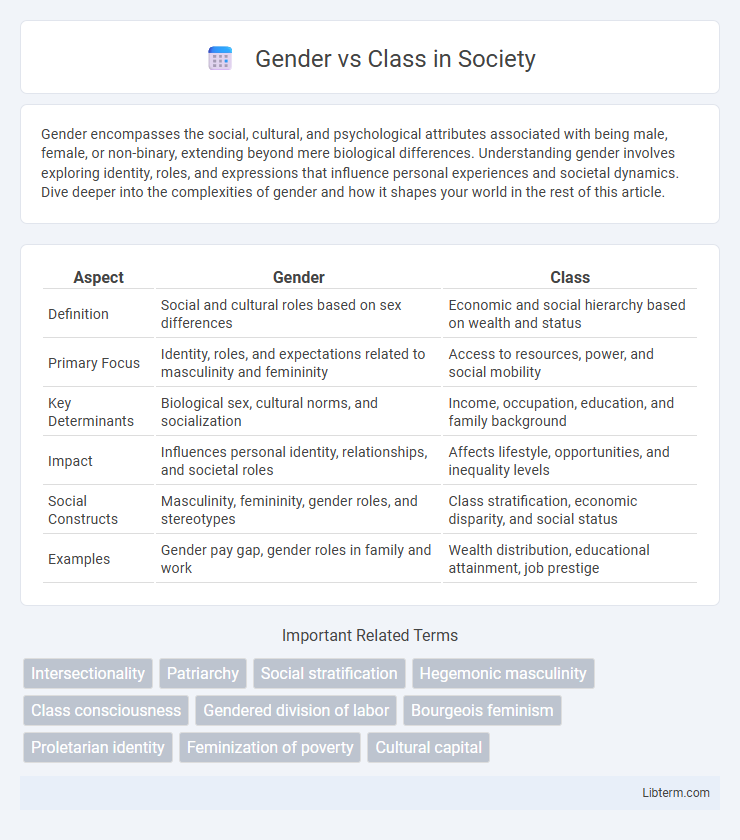Gender encompasses the social, cultural, and psychological attributes associated with being male, female, or non-binary, extending beyond mere biological differences. Understanding gender involves exploring identity, roles, and expressions that influence personal experiences and societal dynamics. Dive deeper into the complexities of gender and how it shapes your world in the rest of this article.
Table of Comparison
| Aspect | Gender | Class |
|---|---|---|
| Definition | Social and cultural roles based on sex differences | Economic and social hierarchy based on wealth and status |
| Primary Focus | Identity, roles, and expectations related to masculinity and femininity | Access to resources, power, and social mobility |
| Key Determinants | Biological sex, cultural norms, and socialization | Income, occupation, education, and family background |
| Impact | Influences personal identity, relationships, and societal roles | Affects lifestyle, opportunities, and inequality levels |
| Social Constructs | Masculinity, femininity, gender roles, and stereotypes | Class stratification, economic disparity, and social status |
| Examples | Gender pay gap, gender roles in family and work | Wealth distribution, educational attainment, job prestige |
Understanding Gender and Class: Defining the Concepts
Gender refers to the social and cultural roles, behaviors, and identities associated with being male, female, or non-binary, distinct from biological sex. Class denotes the hierarchical social stratification based on economic status, occupation, education, and wealth, influencing individuals' access to resources and opportunities. Understanding gender and class involves recognizing how these intersecting identities shape experiences, power dynamics, and social inequalities within societies.
Historical Perspectives on Gender and Class
Historical perspectives on gender and class reveal intertwined systems of power shaping social hierarchies and individual identities. Gender roles often reinforced class divisions, with patriarchal norms privileging men's economic and political dominance while subordinating women, particularly in lower socioeconomic strata. Key historical moments such as industrialization and feminist movements illustrate shifts in class structures and gender relations, highlighting persistent inequalities and struggles for social justice.
How Gender Shapes Social Class Experience
Gender profoundly influences social class experience by shaping access to resources, opportunities, and social networks differently for men and women. Women often encounter wage gaps, occupational segregation, and caregiving responsibilities that restrict economic mobility within their social class. These gendered dynamics interact with class structures to reinforce systemic inequalities and affect life outcomes including health, education, and political participation.
Class Barriers and Gender Inequality
Class barriers intensify gender inequality by limiting access to resources, education, and employment opportunities for women in lower socioeconomic groups. Economic disparities reinforce traditional gender roles, restricting mobility and perpetuating wage gaps across different social strata. Intersectional analysis reveals that addressing class barriers is essential for achieving comprehensive gender equality in policy and social reform.
Intersectionality: Where Gender Meets Class
Intersectionality reveals how gender and class intersect to shape unique social experiences and systemic inequalities. Women in lower socioeconomic classes face compounded barriers due to both gender discrimination and economic disadvantage. Understanding this overlap is essential for developing targeted policies that address the multifaceted nature of oppression.
Gender Roles Across Different Social Classes
Gender roles vary significantly across social classes, influencing expectations, responsibilities, and opportunities for individuals. In upper classes, traditional gender roles often emphasize public success for men and domestic management for women, while working-class families may experience more fluid roles due to economic necessity and labor demands. These class-based distinctions shape identity, power dynamics, and access to resources in diverse social contexts.
Economic Mobility: Gender and Class Dynamics
Economic mobility is significantly influenced by the interplay of gender and class, with women from lower socioeconomic backgrounds facing systemic barriers to upward movement. Wage disparities and occupational segregation limit economic opportunities for women, particularly those from marginalized classes, affecting their earning potential and wealth accumulation. Gendered social expectations combined with limited access to quality education and networks reinforce class-based inequalities, restricting economic mobility across generations.
Policy Impacts on Gender and Class Justice
Policy impacts on gender and class justice reveal significant disparities in access to resources, social services, and economic opportunities. Gender-sensitive policies often emphasize reproductive rights, equal pay, and protection from discrimination, while class-oriented policies prioritize income redistribution, affordable housing, and labor rights. Effective social justice frameworks integrate gender and class analysis to address intersectional inequalities, ensuring more equitable outcomes for marginalized groups.
Breaking Stereotypes: Challenging Gender and Class Norms
Breaking stereotypes around gender and class involves challenging entrenched norms that prescribe distinct roles and behaviors based on socioeconomic status and biological sex. Efforts to dismantle these conventions include promoting inclusivity in education and employment, encouraging diverse representation in leadership, and addressing systemic biases that disproportionately affect marginalized groups. Research indicates that intersectional approaches, which consider both gender and class simultaneously, are most effective in fostering equity and transforming societal expectations.
Future Directions: Addressing Gender and Class Disparities
Future research on gender and class disparities must prioritize intersectional frameworks to capture the complex ways these identities interact and influence social inequalities. Policies targeting economic advancement should integrate gender-sensitive approaches that address systemic barriers faced by marginalized groups in lower socioeconomic classes. Advancements in data analytics and participatory methodologies can enhance the precision of interventions designed to reduce disparities and promote equitable opportunities across diverse populations.
Gender Infographic

 libterm.com
libterm.com